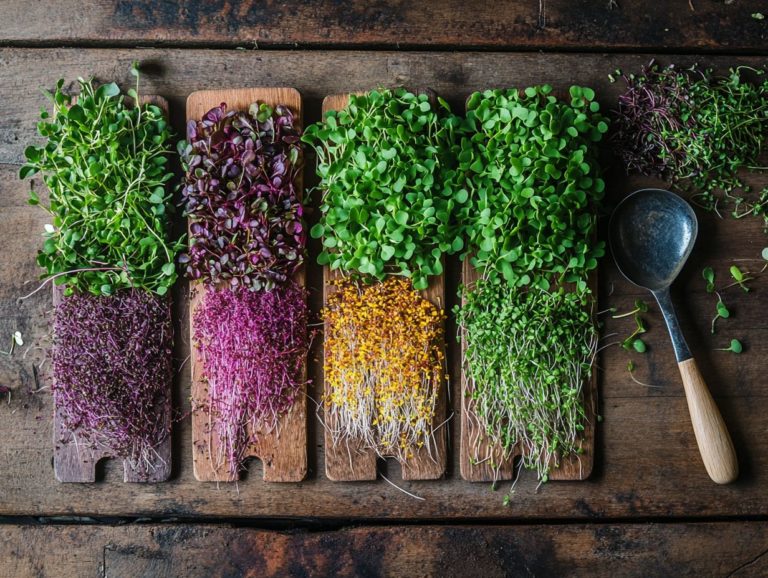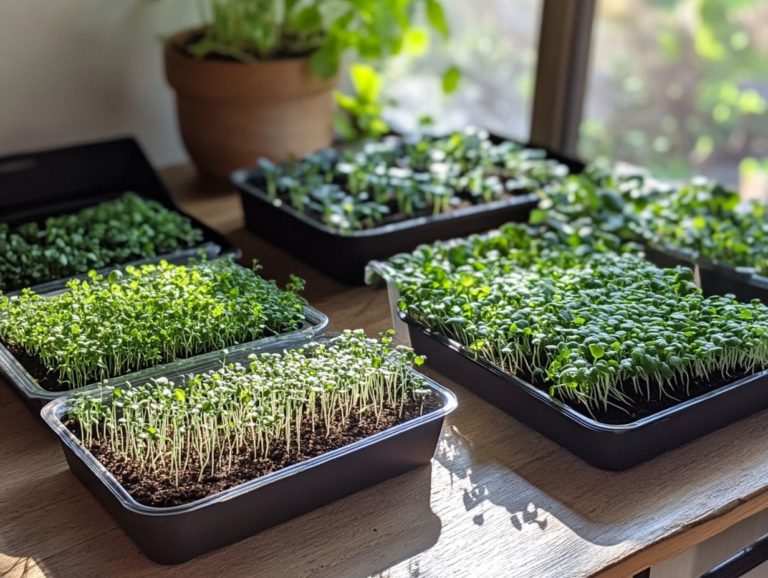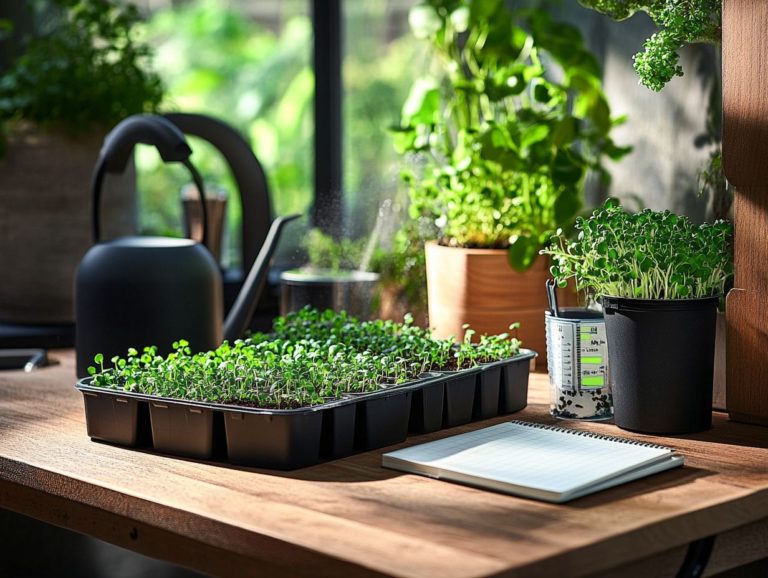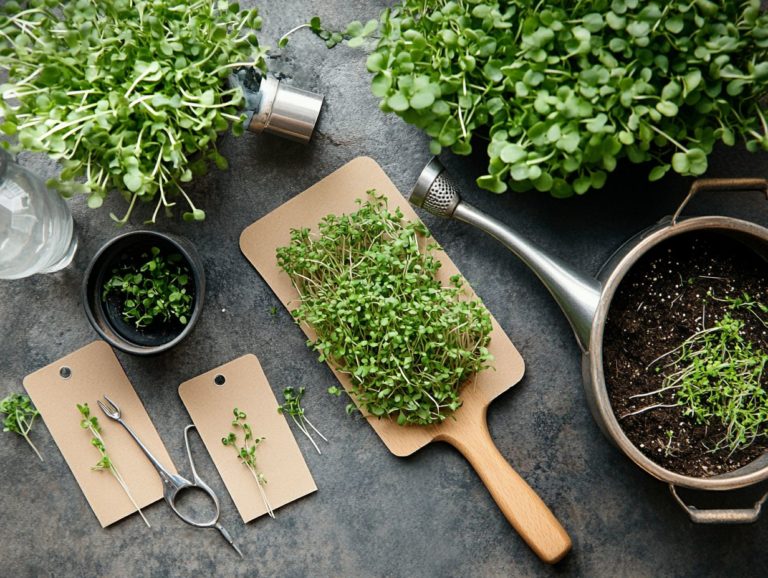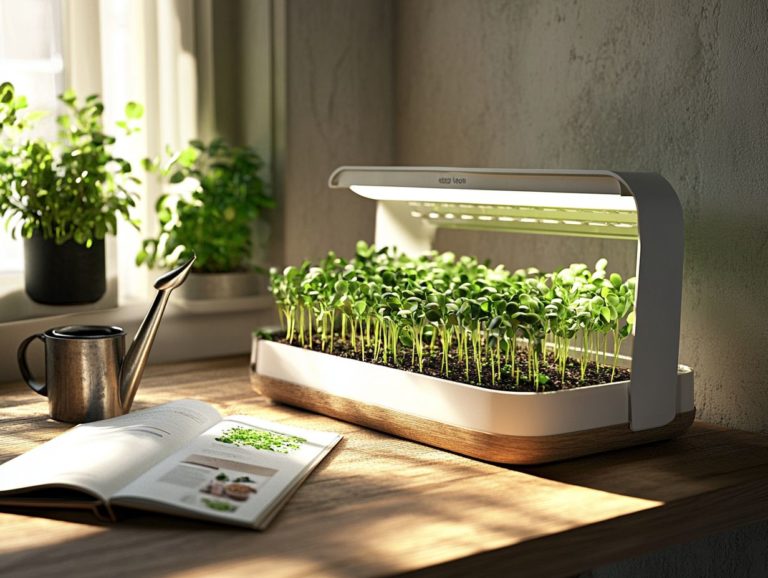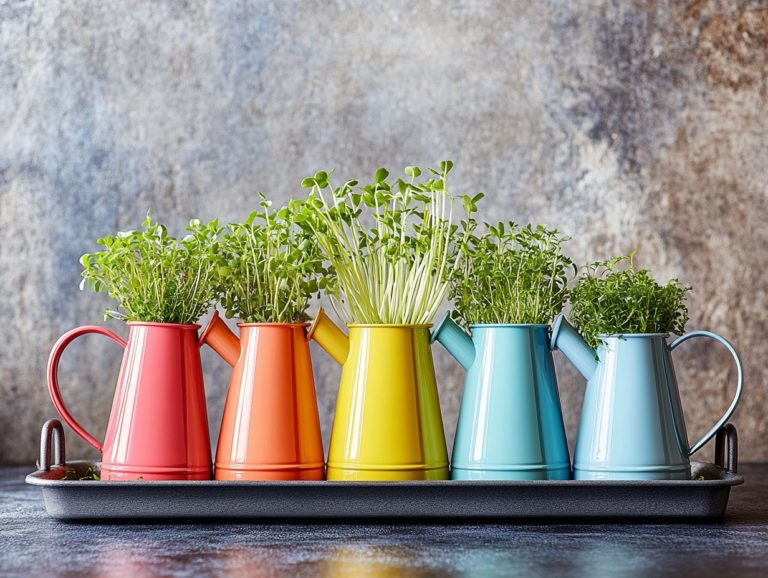Best Containers for Indoor Microgreen Growth
Growing microgreens indoors offers an exhilarating opportunity to enhance your meals with fresh flavors while significantly boosting your nutrition. You can easily introduce nutrient-dense greens into your diet.
Selecting the right container is vital for healthy growth and optimizing your harvest. With options available ranging from versatile plastic and sophisticated ceramic to eco-friendly materials and cutting-edge systems that grow plants in water without soil you have a wealth of choices for your home garden.
This article delves into various container types, helping you discover the ideal fit for your indoor microgreen garden and enhancing your home gardening experience.
Prepare to unleash your culinary creativity and explore the health benefits of fresh microgreens!
Contents
- Key Takeaways:
- 1. Plastic Containers
- 2. Ceramic Containers
- 3. Glass Containers
- 4. Metal Containers
- 5. Wooden Containers
- 6. Fabric or Cloth Containers
- 7. Recycled Containers
- 8. Terracotta Pots
- 9. Self-Watering Containers
- 10. Hanging Containers
- 11. Vertical Garden Containers
- 12. Hydroponic Systems
- 13. Biodegradable Containers
- 14. Stackable Containers
- 15. Creative DIY Containers
- Frequently Asked Questions
- What are the best containers for indoor microgreen growth?
- Can I use any type of container for growing microgreens indoors?
- Do I need to sterilize my containers before planting microgreens?
- Are there any eco-friendly options for containers for indoor microgreen growth?
- Do I need to use special soil for growing microgreens in containers?
- Can I reuse containers for growing microgreens?
Key Takeaways:
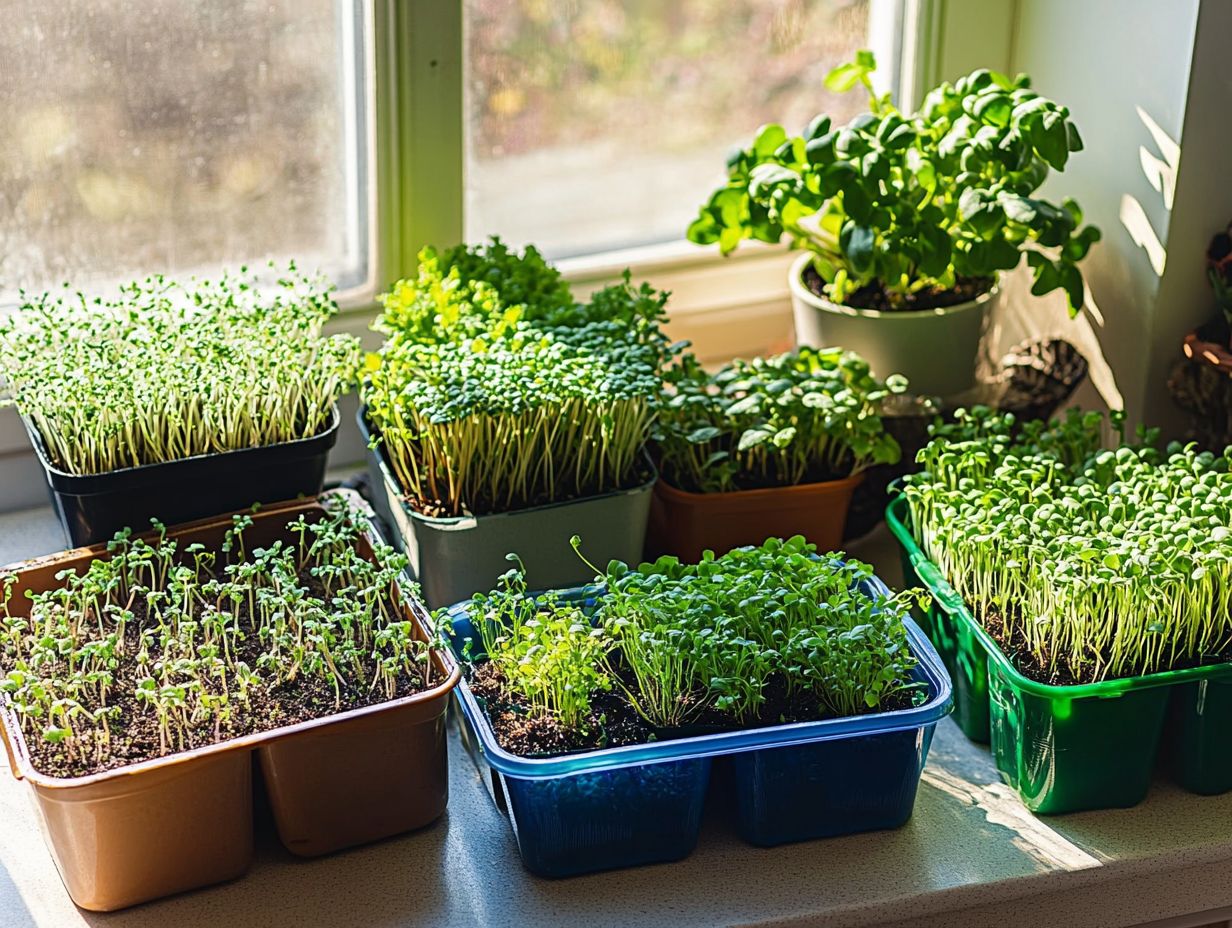
Plastic containers are affordable and widely available, making them a convenient option for growing microgreens indoors.
Ceramic containers provide good drainage and insulation for microgreens, but may be more expensive and fragile compared to other options.
Glass containers are aesthetically pleasing and allow for easy monitoring of water and root growth. However, they may not be suitable for long-term growth due to lack of drainage. For those interested in maximizing their yields, learning how to grow microgreen varieties in containers is essential. They can also be effectively used with grow lights for optimal growth.
1. Plastic Containers
Plastic containers have become a popular choice for growing microgreens at home, and it’s no wonder. Their lightweight design and excellent water drainage make them perfect for cultivating a variety of nutrient-dense greens indoors.
These containers are affordable and come in various sizes and shapes, making it easy for you to start your microgreen journey. Whether you opt for shallow seedling trays or deep planters, each option offers unique benefits. Shallow trays provide better light exposure, while deeper containers retain optimal soil moisture crucial for healthy root development. For a detailed guide, check out how to create a microgreen grow kit.
Caring for plastic containers is super simple and hassle-free! Their smooth surfaces are easy to clean and can be reused multiple times, ensuring a sustainable gardening practice that fits your lifestyle.
2. Ceramic Containers
Ceramic containers offer an aesthetically pleasing choice for growing microgreens, blending functionality with style. They excel at maintaining soil moisture levels, especially when using quality potting soil.
These containers shine in regulating temperature and humidity, creating an ideal environment for your delicate microgreens to thrive. This regulation is essential for keeping those vibrant colors intact and enhancing nutrient content.
However, consider the weight and relatively higher cost of ceramic compared to plastic or metal alternatives. While plastic containers are lightweight and budget-friendly, they often lack thermal properties, leading to moisture fluctuations that could negatively impact your plants health.
3. Glass Containers
Glass containers present an exceptional option for your indoor gardening, allowing ample light to filter through while beautifully showcasing the vibrant colors of your microgreens. This elevates the aesthetic appeal of your home garden and enhances its health benefits, such as providing vitamin K and vitamin C.
The transparency of these containers offers an unobstructed view of your plants, making it easy to monitor moisture levels and ensure your garden remains lush and thriving. This is particularly advantageous for those who take pride in nurturing their plants with attention and care.
Beyond their gardening prowess, these versatile vessels can transition into stunning home decor elements, becoming captivating centerpieces or chic storage solutions. Just remember to handle them with care; their fragility requires a delicate touch, balancing beauty and practicality in your living space.
In conclusion, whether you choose plastic, ceramic, or glass containers, each option offers unique benefits for growing microgreens indoors. For more information, explore the benefits of indoor microgreen growing. Start your microgreen journey today and enjoy the vibrant flavors and health benefits they bring!
4. Metal Containers
Metal containers are increasingly popular for small-scale gardening, especially for growing microgreens. They are durable and drain water effectively, making them an excellent choice, particularly when paired with grow lights to create optimal indoor growth conditions.
The robust structure of these containers allows them to withstand various environmental factors, including changing temperatures and harsh weather. This reliability is perfect for gardeners who prioritize longevity in their planting solutions.
You can enhance these containers with insulation or specialized liners. These features help maintain an ideal temperature for root systems while retaining essential soil moisture, which is important for soaking seeds before planting. To learn more about optimizing your space, check out this guide on how to grow microgreens in small containers. This ensures your microgreens thrive, even when external conditions are less than ideal, reinforcing the appeal of metal containers in sustainable gardening.
5. Wooden Containers
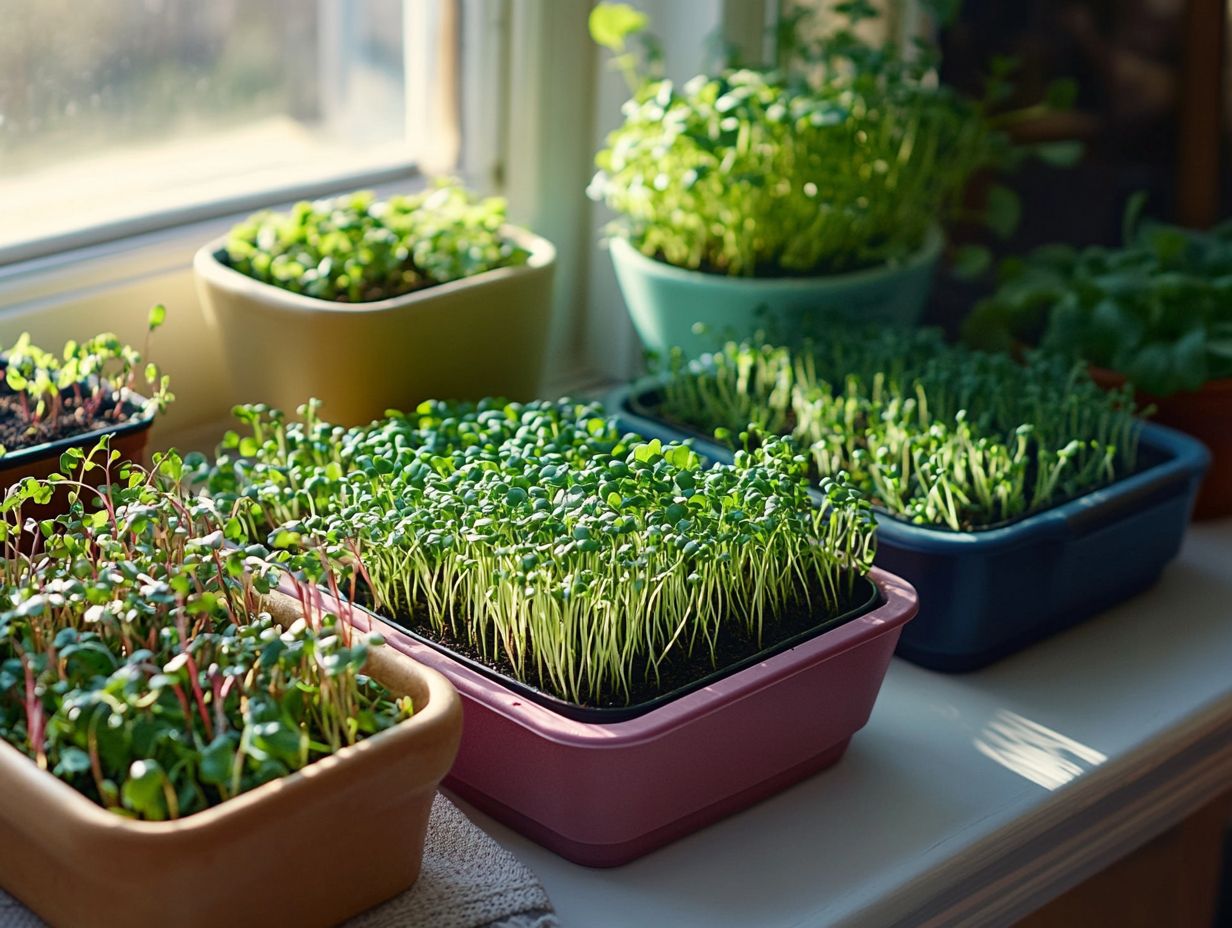
Wooden containers present a timeless choice for home gardening. They offer rustic charm while proving highly effective for cultivating microgreens when filled with organic potting soil rich in nutrients.
These containers elevate the visual allure of your garden space and provide practical benefits, like regulating temperature and humidity. The porous nature of wood allows for optimal airflow, fostering healthy growth and preventing excess moisture that could impede plant development.
To ensure longevity and stave off rot, treat the wood with natural preservatives or sealants safe for growing microgreens. This enhances durability and keeps things safe for your plants. Regular maintenance, such as cleaning and inspecting for signs of wear, will keep these containers in top-notch condition. For optimal results, consider following the best practices for indoor microgreens, allowing you to savor their beauty and utility for many seasons ahead.
6. Fabric or Cloth Containers
Fabric or cloth containers offer a sophisticated, eco-friendly alternative for cultivating microgreens. They excel in retaining soil moisture while providing excellent breathability, making them ideal for indoor gardening, especially with grow lights.
These containers are lightweight and portable, allowing you to reposition them easily to catch sunlight or artificial lighting. They also promote healthier root systems by encouraging air pruning, a natural process that encourages roots to grow stronger and healthier, preventing root circling and root-bound plants.
When these fabric containers have fulfilled their purpose, they will naturally decompose, supporting sustainable gardening practices. By opting for fabric containers, you elevate your growing environment and embrace eco-conscious living, positively contributing to the health of our planet.
7. Recycled Containers
Recycled containers offer a sustainable solution for your home gardening endeavors! You can grow microgreens while embracing eco-friendly practices and maximizing existing materials, such as old yogurt cups.
These containers can take many forms—think old yogurt cups, egg cartons, or even takeout boxes. Each one is a clever way to reduce waste and save money while providing a unique opportunity for experimenting with microgreen seeds. For the best options, consider the best containers for microgreen cultivation. By repurposing these items, you’re crafting an engaging gardening experience that adds a touch of creativity to your routine.
To prepare these containers for planting, be sure to clean them thoroughly and create drainage holes to prevent waterlogging. This simple yet effective step retains moisture while allowing excess water to escape, ultimately boosting nutrient retention and fostering the healthy growth of your vibrant microgreens, ensuring a rich supply of iron and magnesium.
Try using recycled containers today and discover how fun and rewarding gardening can be!
8. Terracotta Pots
Terracotta pots offer a timeless and highly effective solution for growing microgreens, particularly in a south-facing window. Their exceptional ability to regulate soil moisture makes them ideal for home gardening, especially in sunny windowsills where light exposure is maximized.
The porous nature of terracotta not only encourages air exchange but also maintains the perfect moisture levels essential for healthy root development. Unlike plastic containers that can trap excess moisture and invite root rot, terracotta pots create a balanced environment that aids in harvesting microgreens efficiently. This is especially advantageous for microgreens, which flourish in conditions that expertly avoid both overwatering and drought stress.
Beyond their practical benefits, terracotta pots add an earthy aesthetic that infuses rustic charm into indoor spaces. They are a favored choice among gardeners who wish to blend functionality with visual appeal, transforming any space into a vibrant oasis.
Try using terracotta pots today and watch your microgreens flourish!
9. Self-Watering Containers
Self-watering containers offer you an innovative solution for cultivating microgreens, maintaining consistent soil moisture levels through a built-in reservoir. This makes them perfect for home gardeners like yourself, who desire optimal growth without the hassle of constant upkeep.
These clever designs let your plants draw water as needed via a water-absorbing method, effectively eliminating the risks of over- or under-watering. For those nurturing microgreens, this technology means your plants can flourish without requiring your constant attention, leading to quicker germination and healthier harvests.
When you combine these containers with grow lights, you create an environment that mimics natural sunlight, further enhancing growth rates and making your indoor gardening experience seamless. With their efficiency and user-friendly design, you ll be amazed at how easy it is to grow lush green crops!
Start your journey with self-watering containers today!
10. Hanging Containers
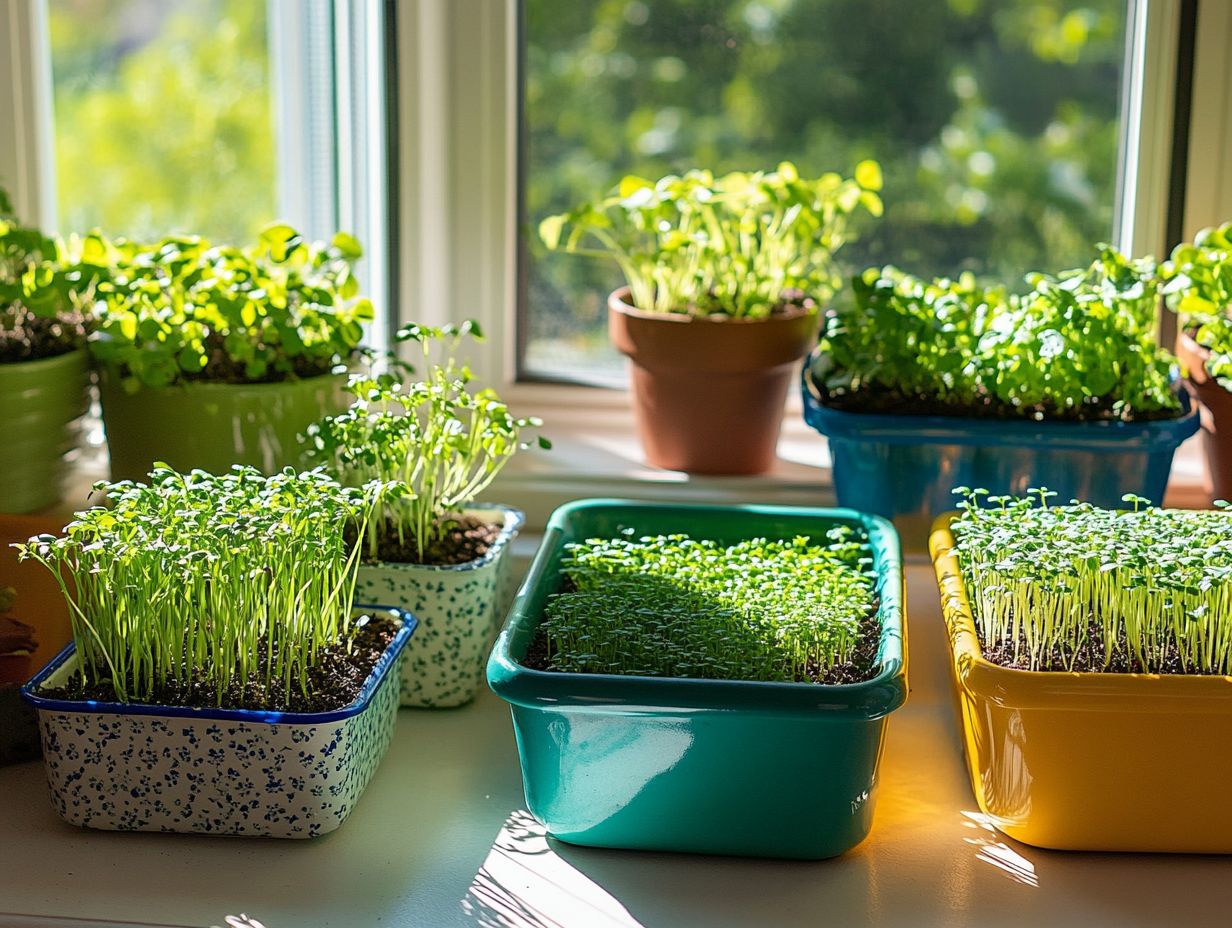
Hanging containers present a creative and space-efficient way for you to grow microgreens, allowing you to maximize light exposure while adding a distinct aesthetic to your indoor garden.
You ll find these containers in a range of designs, from sleek modern looks to charming rustic options, catering to your personal style and interior decor. Crafted from materials like recycled plastics, biodegradable ceramics, and even metal, they offer durability along with various drainage capabilities, which are essential for healthy root development.
When selecting your containers, consider the unique needs of different microgreens. Some may flourish in deeper pots, while others thrive in shallower ones. To truly optimize growth, position your hanging containers in well-lit areas, ideally near a window with indirect sunlight. For more tips on this, check out our guide on how to choose the right soil for microgreen growth while ensuring they remain easily accessible for harvesting and maintenance.
Discover the joy of hanging containers for your microgreens and elevate your indoor gardening game!
11. Vertical Garden Containers
Vertical garden containers offer an innovative approach to maximizing your home gardening space. This allows you to start growing your microgreens today, even in the tightest of spaces!
These systems not only optimize space but also enhance light exposure essential for effective photosynthesis. Each tier of a vertical garden ensures that every plant basks in ample sunlight, tackling the pesky shading issues often encountered in traditional gardening methods.
Plus, air circulation improves significantly in this vertical arrangement, helping to prevent mold and pests, which fosters a healthier environment for your plants.
With a variety of designs available ranging from wall-mounted units to free-standing towers these systems can easily blend into your indoor spaces. This makes it simpler for you to indulge your passion for gardening, no matter how limited your space may be.
Embrace vertical gardening today and transform your home into a flourishing green space!
12. Hydroponic Systems
Hydroponic systems present a cutting-edge solution for growing microgreens efficiently without the need for soil. Instead, you ll rely on nutrient-rich water solutions that foster rapid growth and ensure optimal drainage.
This innovative method speeds up sprouting and maturation, resulting in a more nutrient-dense product. This makes it an appealing choice for those who prioritize health.
You ll find various hydroponic systems available, including deep water culture, nutrient film technique (a method where a thin film of nutrient solution flows over plant roots), and aeroponics. Each offers unique benefits tailored to different living environments.
For home gardening enthusiasts, these systems can be seamlessly integrated into compact spaces, providing a sustainable way to grow vibrant microgreens year-round. By embracing these techniques, you ll enjoy fresher produce while significantly reducing water usage compared to traditional gardening methods.
13. Biodegradable Containers
Biodegradable containers are the perfect eco-conscious choice for your home gardening efforts, helping the growth of microgreens while minimizing your environmental impact.
By utilizing organic potting soil, you’re setting the stage for healthy plant development. These containers are crafted from sustainable materials like cornstarch, bamboo, and palm leaves, which break down naturally over time.
Unlike traditional plastic pots that can linger in landfills for centuries, biodegradable options decompose gracefully, enriching the soil and promoting a healthier ecosystem. As they gradually break down, these containers return essential nutrients to the earth, enhancing your sustainable gardening practices.
This natural process not only reduces waste but also supports your plants’ roots, allowing them to access nutrient-rich soil and minimizing the risk of root rot. The result? A more vibrant garden that thrives beyond the limitations imposed by conventional plastic containers.
14. Stackable Containers
Stackable containers provide a sophisticated and space-efficient solution for growing microgreens, allowing you to fully utilize your home garden while ensuring accessibility and ease of maintenance.
These structures optimize vertical space and improve airflow and light exposure, both essential for the thriving growth of delicate greens. For those interested in innovative methods, exploring soil alternatives for microgreen growing can enhance your setup. With the ability to adjust the height and arrangement of these containers, you can customize your setup to fit perfectly into various spots, such as a sun-kissed kitchen window or a charming balcony.
By incorporating stackable containers into your gardening approach, you can nurture a vibrant array of microgreens using sprouting trays for microgreens while ensuring that each layer receives the sunlight and ventilation it needs. This will boost yields without sacrificing convenience or visual appeal.
15. Creative DIY Containers
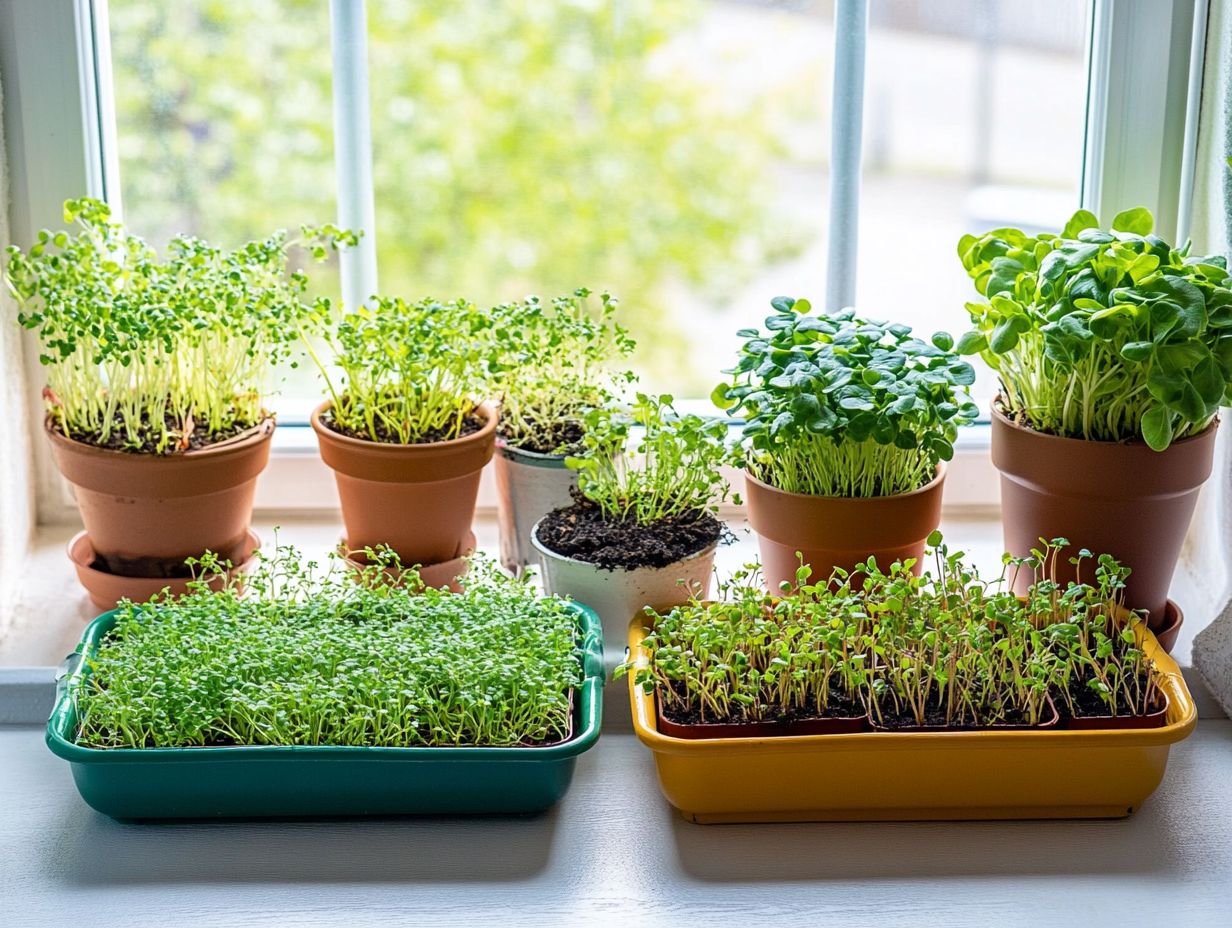
Creative DIY containers offer a thrilling chance to embrace home gardening like never before. By using everyday items to grow microgreens, you blend creativity with sustainability, personalizing your gardening journey.
Transforming ordinary objects think tin cans, plastic bottles, or even that old furniture you ve been meaning to toss into functional planters allows you to save money and reduce household waste. Picture this: repurposing an old wooden crate into a charming herb garden or crafting an elegant terrarium from a glass jar.
Every project begins with a clear vision and just a few simple tools. From drilling drainage holes to selecting the perfect soil mix, your journey of growing lush microgreens evolves into an engaging hands-on experience. To learn more about this process, check out our guide on how to grow microgreens in a greenhouse. Participating in these creative endeavors not only yields delicious results but fosters a deeper connection to nature.
Frequently Asked Questions
Have more questions about home gardening? Start your gardening journey today! Explore more about home gardening or share your own experiences.
What are the best containers for indoor microgreen growth?
Several containers thrive for growing microgreens indoors. Popular choices include trays with drainage holes, shallow plastic containers, and even repurposed items like egg cartons.
Can I use any type of container for growing microgreens indoors?
While many options exist, it’s crucial to select a container with good drainage and enough space for the roots. Avoid using containers that are too deep; this can cause water to pool at the bottom, leading to root rot.
Do I need to sterilize my containers before planting microgreens?
Yes! Sterilizing your containers is essential to protect your microgreens from diseases and pests. Clean them thoroughly to kill germs by washing with hot, soapy water or soaking in a diluted bleach solution.
Are there any eco-friendly options for containers for indoor microgreen growth?
Absolutely! You can use trays that break down naturally or homemade containers from recycled materials. Just ensure they have proper drainage and are sturdy enough for your growing microgreens.
Do I need to use special soil for growing microgreens in containers?
No need for special soil! Regular potting soil works well, but make sure it s well-draining and free from harmful fertilizers or chemicals that could damage your delicate microgreens.
Can I reuse containers for growing microgreens?
Yes, you can! Just remember to clean and sterilize them between uses. This practice helps reduce waste and saves you money on new containers every time you want to grow microgreens.

